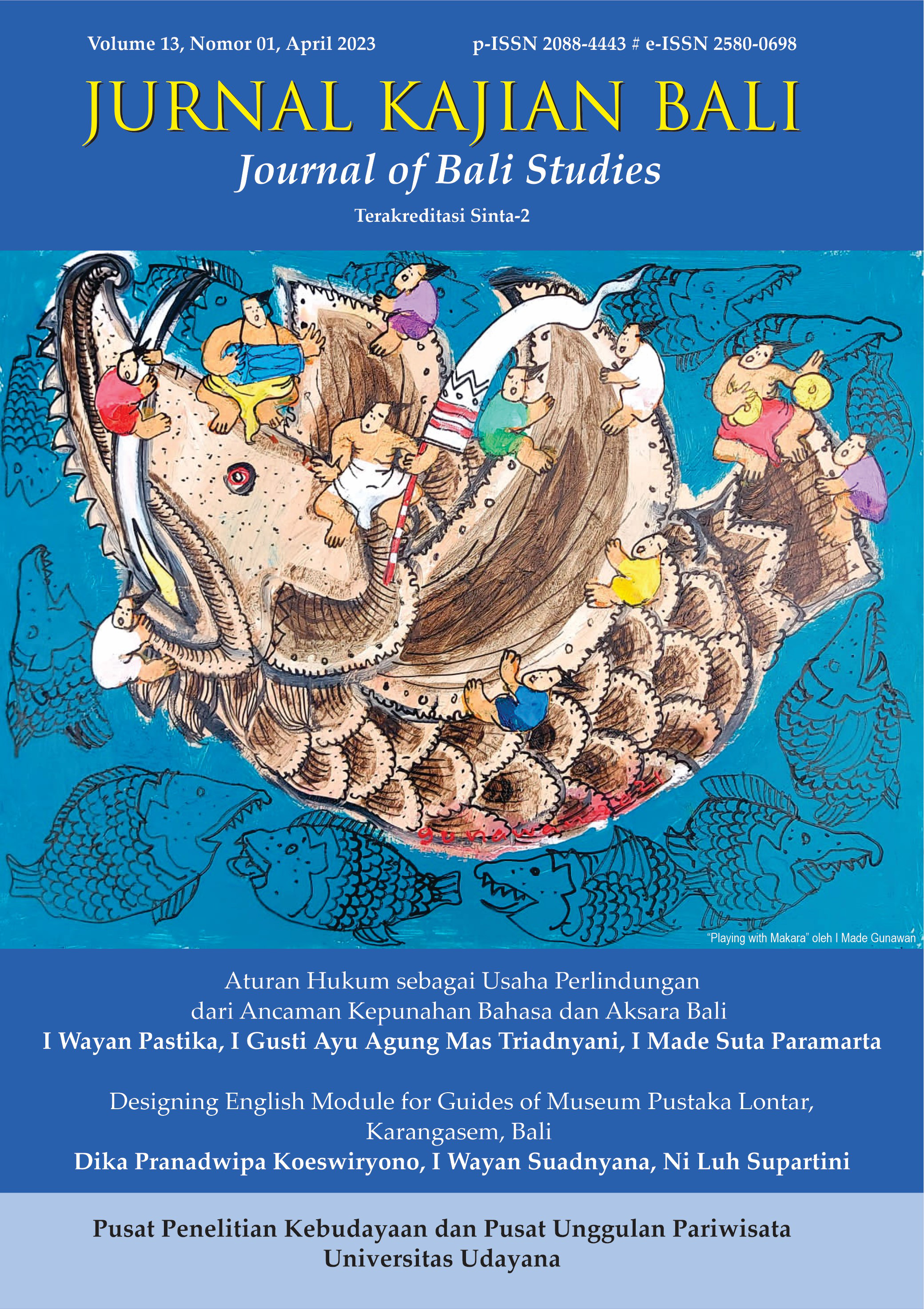Strategi Growth-Oriented dalam Pengembangan Desa Wisata Aan di Kabupaten Klungkung Bali
Abstract
The study aims to formulate an effective development strategy for Aan Village by identifying strengths, weaknesses, opportunities, and threats. Aan tourism Village with a diversity of attractions should be well developed using an appropriate strategy. The study used a qualitative approach where the researcher became the research instrument. Data collection techniques used were observations, interviews, documentation, and triangulation techniques to check the credibility of the data. It was found that Aan Village has several potential tourist attractions such as landscapes, waterfall, river, culture, art, and history. The study found that growth-oriented strategies are suitable to be implemented in Aan tourism village which includes backward integration, forward integration, horizontal integration, market penetration, market development, and product development. Implementing those grand strategies will help Aan village meet the needs of the tourists who, based on the recent trend, demand nature, eco, wellness, and adventure concepts.
Downloads
References
David, F., & David, F. R. (2016). Strategic management: A competitive advantage approach, concepts and cases (p. 696). Florence: Pearson–Prentice Hall.
Deputi Bidang Kebijakan Strategis. (2020). Tren industri pariwisata 2021. Jakarta. https://kemenparekraf.go.id/pustaka/Buku-Tren-Pariwisata-2021
Flick, U. (2007). Designing qualitative research, 68-76. New York: Sage Publications Ltd.
Google Maps (2022, 16 April). Desa Wisata Aan. https://www.google.com/maps.
Gorda, A. N. O. S., Prayoga, K. B. S., & Anggreswari, N. P. Y. (2021). Komunikasi pemasaran objek wisata Aan Secret Waterfall berbasis digital. Ganaya: Jurnal ilmu sosial dan humaniora, 4(1), 29-39.
Indonesia. Badan Pusat Statistik. (2022). Jumlah desa di Indonesia. https://www.bps.go.id/
Indonesia. Kementerian Pariwisata dan Ekonomi Kreatif. (2022). Anugerah Desa Wisata Indonesia (ADWI). https://jadesta.kemenparekraf.go.id/
Kastenholz, E., Eusébio, C., & Carneiro, M. J. (2018). Segmenting the rural tourist market by sustainable travel behaviour: Insights from village visitors in Portugal. Journal of destination marketing & management, 10, 132-142.
Kotler, P., & Keller, K. L. (2010). Manajemen pemasaran. (Edisi 13 jilid 2). Jakarta: Erlangga.
Nuryanti, W., 1993. Concept, perspective and challenges. Laporan Konferensi Internasional Pariwisata Budaya. Yogyakarta: Gadjah Mada University Press.
Pemerintah Kabupaten Klungkung. (2021). Peraturan Bupati Klungkung nomor 8 tahun 2021 tentang perubahan atas peraturan bupati nomor 2 tahun 2017 tentang penetapan desa wisata di Kabupaten Klungkung.
Pitana, I. G., & Pitanatri. (2021). Pemasaran pariwisata perdesaan: Menggerakkan wisatawan nusantara dalam upaya pemulihan pariwisata Bali dalam tatanan kehidupan baru. (Edisi I). Singaraja: Mahima Institute Indonesia.
Putra. I. N. D., Anyani, N. W.G., Murnati, D. (2021). Bali sweet escapes: Mengenal Desa Wisata Cau Belayu. (Edisi Pertama). Denpasar: Pustaka Larasan.
Putra, I. N. D., Paturusi, S. A. (2017). Metamorfosis pariwisata tentang membangun pariwisata berkelanjutan. (Edisi Satu). Denpasar: Pustaka Larasan
Putrayasa, I. M. A., Astuti, N. N. S., Ayuni, N. W. D., & Adiaksa, I. M. A. (2020). Implementasi green tourism dalam pemberdayaan masyarakat untuk pengembangan wisata edukasi di Dusun Petapan Desa Aan Kabupaten Klungkung. Bhakti Persada Jurnal Aplikasi IPTEKS, 6(1), 46-55.
Rangkuti, F. (2016). Teknik membedah kasus bisnis Analisis SWOT. Jakarta: Gramedia Pustaka Utama.
Sugiyono, D. (2013). Metode penelitian pendidikan pendekatan kuantitatif, kualitatif dan R&D. Bandung: Alfabeta.
Tanaya, I. G. L. P., & Parta, G. L. (2019). Strategi pengembangan desa wisata. KEMENDESA RI. Jakarta.

This work is licensed under a Creative Commons Attribution 4.0 International License.



















